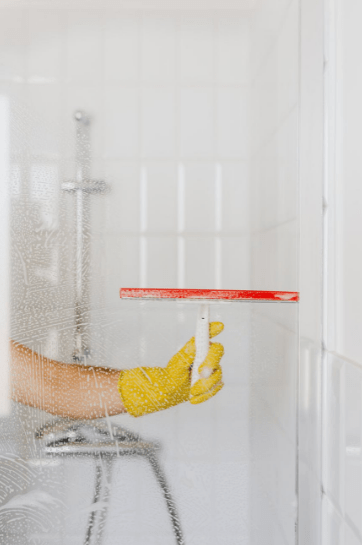Soap scum, also known as multifarious sludge or lime soap, is one of the many annoying sedentary mess you can see sitting on your shower, tubs, sink, or bathroom fixtures. This off-white, often yellowish, flaking residue is a dried substance formed by the reaction of salts and minerals found in the mixture of hard water and soap you use. What makes it more unpleasant is that it causes odor, scaling on and discoloration of surfaces.
Scientifically speaking, hard water contains calcium and magnesium ions which react with the sodium cations in soap to produce calcium stearate and magnesium stearate – the primary components of that filmy yuck you see on your surfaces. The gross part is that soap scum also includes body oils, dead skins, and all those other dirt in your shower or sink!
When ignored and left unwiped for too long, soap scum can be very hard to remove as it can further combine with mould and mildew to get as hard as a concrete material. Prevention is also required since soap scum contributes to faster corrosion of glass and metal fixtures. It is therefore necessary that you know how to remove this unpleasant mess to save you money, time and effort in the long run.
Continue reading this article to learn how to remove and prevent soap scum from ruining the cleanliness of your shower or sink so you have a Perfect Bathroom.
There are many ways – or at least many solutions – to remove soap scum depending on which surface it sits on. The most commonly used soap scum removers are acidic substances such as baking soda, ammonia, vinegar, degreasing agents, and lemon oil. These substances are effective because soap scum breaks when exposed to them. In all the tested and proven ways, however, one solution seems to be the cheapest and most convenient – vinegar! This solution can be used to totally wipe out soap scum on your surfaces and the how-tos are provided below.
Shower Walls
Create a mixture of 1 cup of vinegar and 1 cup of water in a clean bottle spray. Shake this mixture. For a stronger cleaning effect especially on tough areas, a tablespoon of dish soap may also be added to the vinegar-water mixture.
Spray the mixture you created on the soap scum found on your shower walls and other bathroom fixtures. After at least 20 minutes of letting the mixture sit, scrub the area with a sponge. Use circular motion for this step for deeper cleaning. Repeat this process until the soap scum is completely eliminated.
Sink
The sink is harder to clean than shower walls because of its irregular shape, so a stronger solution is needed to wipe out soap scum on this surface. To clean this particular area, add 1 cup of baking soda to 1/4 cup of vinegar on a mixing bowl. Let the mixture foam to create a scrubbing paste.
Apply the mixture to the soap scum using a sponge and let it sit for 20-30 minutes. Then, using a brush, scrub the area in circular motion and repeat the process until the sink is completely cleaned.
Removing Years of Soap Scum
Removing soap scum built up for many years can be very challenging because vinegar alone cannot solve the issue. You need a stronger solution for this daunting task. For years of soap scum, hydrogen peroxide is the best replacement for vinegar as it possesses the latter’s cleaning power but with an additional bleaching effect.
On a mixing bowl, mix 1 cup of hydrogen peroxide and 2 cups of baking soda. Apply the mixture to the soap scum using a cloth and let it sit for at least 1 hour. Add water to the area and use a brush to scrub it circular motion. For the toughest areas, you may apply baking soda on the brush before scrubbing it. Repeat the process until the soap scum is completely gone.
Preventing Soap Scum
Preventive measures for soap scup include cleaning your bathroom regularly and washing your shower curtains at least once a week. You may also use commercial soap specially formulated to remove soap scum. Furthermore, tt has been proven that the more minerals found in hard water, the more likely soap scum is going to build up. To prevent soap scum from forming to an unpleasant extent, you may opt to use water softener or use liquid soap instead of bar soap.
Soap scum will always be a part of your bathroom struggles unless you stop using the shower or sink, or remove soap from your daily bathroom routine. Since you probably cannot afford to do that, it is best for you to remember the ways elaborated above to remove and prevent soap scum.

